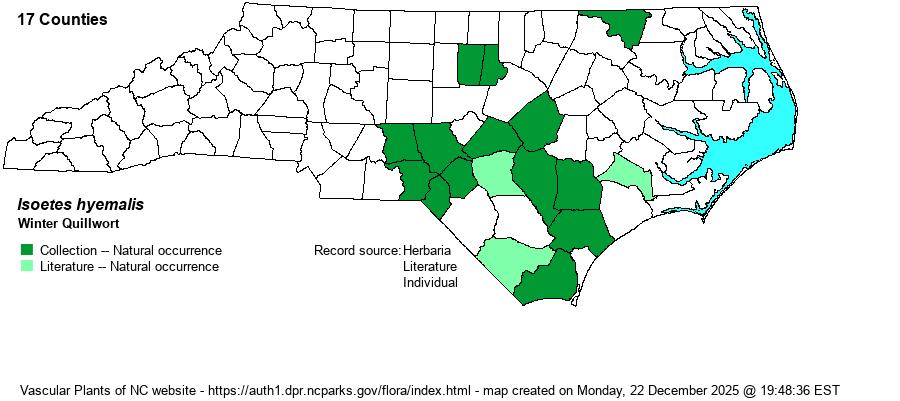| Author | D.F. Brunton | |
| Distribution | Present over nearly all of the southwestern 45% of the Coastal Plain, especially in the Sandhills region -- ranging north to Johnston and Jones counties, sparingly to the VA border. A few records in the eastern Piedmont.
This is a Southeastern species, ranging only from southern VA south to northwestern FL and adjacent AL. | |
| Abundance | Apparently uncommon in the Sandhills, and infrequent eastward in the Coastal Plain. Very rare, perhaps, in the northern Coastal Plain, but there are many records from southeastern VA, and thus it is likely overlooked in NC's northern Coastal Plain. The State Rank and Global Rank seem to be overly conservative, as it seems to be at least S3 in the state, and thus G3 if not G3G4 globally. Though the NCNHP has this as a Watch List species, it perhaps does not need to be on this list. | |
| Habitat | This species occurs in "Seasonally wet channels and sloughs in swamp forests, shallow streams, river shores, and, rarely, clayey upland depressions" (Digital Atlas of the Virginia Flora website). These waters are usually quite acidic, as Weakley (2018) mentions that it occurs in "Blackwater streams and sandy streambanks". | |
| Phenology | Fruiting period has not been described. | |
| Identification | All Isoetes species are quite grass-like, with numerous very slender and grass-like leaves growing from a common base. Most importantly, they are swollen at the base, where the megaspores are present, the key structure for separation of species. The leaves are terete (rounded) and hollow. For identification, see the key in Weakley (2018). | |
| Taxonomic Comments | This species was fairly newly described by Brunton et al. (1994), pulled out from I. engelmannii.
All Isoetes species are quite grass-like, with numerous very slender and grass-like leaves growing from a common base. Most importantly, they are swollen at the base, where the megaspores are present, the key structure for separation of species. The leaves are terete (rounded) and hollow. For identification, see the key in Weakley (2018). | |
| Other Common Name(s) | Wintergreen Quillwort, Evergreen Quillwort | |
| State Rank | S2S3 [S3] | |
| Global Rank | G2G3 [G3?] | |
| State Status | W7 [W1] | |
| US Status | | |
| USACE-agcp | OBL link |
| USACE-emp | OBL link |

